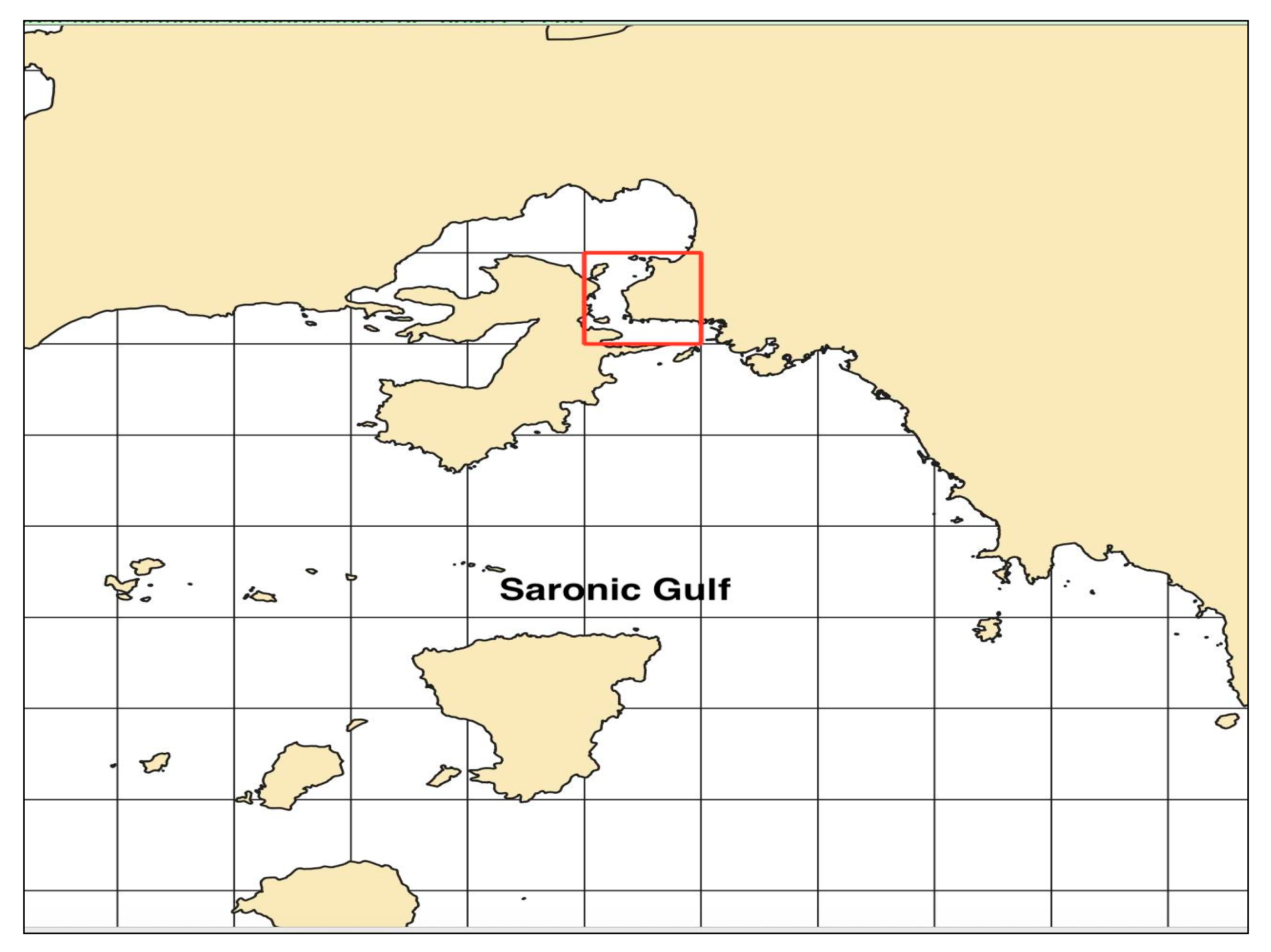Air Quality Benefits of Ship Electrification: A Modeling Case Study for Saronic Gulf, Greece †
Abstract
1. Introduction
2. Materials and Methods
2.1. Modeling System
2.2. Shipping Emissions on Perama–Paloukia Line
2.3. Simulation Scenarios
3. Results and Discussion
4. Conclusions
Author Contributions
Funding
Informed Consent Statement
Data Availability Statement
Acknowledgments
Conflicts of Interest
References
- Di Natale, F.; Carotenuto, C.; Cajora, A.; Sippula, O.; Gregory, D. Short-Sea Shipping Contributions to Particle Concentration in Coastal Areas: Impact and Mitigation. Transp. Res. Part D Transp. Environ. 2022, 109, 103342. [Google Scholar] [CrossRef]
- Jonson, J.E.; Gauss, M.; Schulz, M.; Jalkanen, J.-P.; Fagerli, H. Effects of Global Ship Emissions on European Air Pollution Levels. Atmos. Chem. Phys. 2020, 20, 11399–11422. [Google Scholar] [CrossRef]
- Grigoriadis, A.; Mamarikas, S.; Ntziachristos, L. Quantitative Impact of Decarbonization Options on Air Pollutants from Different Ship Types. Transp. Res. Part D Transp. Environ. 2024, 133, 104316. [Google Scholar] [CrossRef]
- Zhang, Y.; Li, R.; Fu, S.; Shi, M.; Han, Z.; Zhang, Y.; Chen, J. Driving Factors of Ship-Induced Nitrogen Dioxide Concentrations over Coastal Seas of China: Implications for Ship Emission Management. J. Environ. Manag. 2025, 373, 123894. [Google Scholar] [CrossRef] [PubMed]
- Roy, A.; Chakraborty, M. A Review of Ship Emissions Impacts on Environmental, Health, Societal Impacts and IMO’s Mitigation Policies. Reg. Stud. Mar. Sci. 2025, 81, 103964. [Google Scholar] [CrossRef]
- Tokaya, J.P.; Kranenburg, R.; Timmermans, R.M.A.; Coenen, P.W.H.G.; Kelly, B.; Hullegie, J.S.; Megaritis, T.; Valastro, G. The Impact of Shipping on the Air Quality in European Port Cities with a Detailed Analysis for Rotterdam. Atmos. Environ. X 2024, 23, 100278. [Google Scholar] [CrossRef]
- Viana, M.; Hammingh, P.; Colette, A.; Querol, X.; Degraeuwe, B.; Vlieger, I.D.; Van Aardenne, J. Impact of Maritime Transport Emissions on Coastal Air Quality in Europe. Atmos. Environ. 2014, 90, 96–105. [Google Scholar] [CrossRef]
- Wang, Z.; Liao, P.; Long, F.; Wang, Z.; Ji, Y.; Han, F. Maritime Electrification Pathways for Sustainable Shipping: Technological Advances, Environmental Drivers, Challenges, and Prospects. eTransportation 2025, 26, 100462. [Google Scholar] [CrossRef]
- Vakili, S.; Insel, M.; Singh, S.; Ölçer, A. Decarbonizing Domestic and Short-Sea Shipping: A Systematic Review and Transdisciplinary Pathway for Emerging Maritime Regions. Sustainability 2025, 17, 7294. [Google Scholar] [CrossRef]
- Ramacher, M.O.P.; Tang, L.; Moldanová, J.; Matthias, V.; Karl, M.; Fridell, E.; Johansson, L. The Impact of Ship Emissions on Air Quality and Human Health in the Gothenburg Area—Part II: Scenarios for 2040. Atmos. Chem. Phys. 2020, 20, 10667–10686. [Google Scholar] [CrossRef]
- Skamarock, W.; Klemp, J.; Dudhia, J.; Gill, D.; Barker, D.; Wang, W.; Huang, X.-Y.; Duda, M. A Description of the Advanced Research WRF Version 3; UCAR/NCAR: Boulder, CO, USA, 2008. [Google Scholar]
- Ramboll. CAMx User’s Guide Comprehensive Air Quality Model with Extensions; Ramboll: Novato, CA, USA, 2018. [Google Scholar]
- Liora, N.; Markakis, K.; Poupkou, A.; Giannaros, T.M.; Melas, D. The Natural Emissions Model (NEMO): Description, Application and Model Evaluation. Atmos. Environ. 2015, 122, 493–504. [Google Scholar] [CrossRef]
- Kuenen, J.; Dellaert, S.; Visschedijk, A.; Jalkanen, J.-P.; Super, I.; Denier Van Der Gon, H. CAMS-REG-v4: A State-of-the-Art High-Resolution European Emission Inventory for Air Quality Modelling. Earth Syst. Sci. Data 2022, 14, 491–515. [Google Scholar] [CrossRef]
- Johansson, L.; Jalkanen, J.-P.; Kukkonen, J. Global Assessment of Shipping Emissions in 2015 on a High Spatial and Temporal Resolution. Atmos. Environ. 2017, 167, 403–415. [Google Scholar] [CrossRef]
- Liora, N.; Kontos, S.; Parliari, D.; Akritidis, D.; Poupkou, A.; Papanastasiou, D.K.; Melas, D. “On-Line” Heating Emissions Based on WRF Meteorology—Application and Evaluation of a Modeling System over Greece. Atmosphere 2022, 13, 568. [Google Scholar] [CrossRef]
- Fameli, K.-M.; Assimakopoulos, V.D. The New Open Flexible Emission Inventory for Greece and the Greater Athens Area (FEI-GREGAA): Account of Pollutant Sources and Their Importance from 2006 to 2012. Atmos. Environ. 2016, 137, 17–37. [Google Scholar] [CrossRef]


Disclaimer/Publisher’s Note: The statements, opinions and data contained in all publications are solely those of the individual author(s) and contributor(s) and not of MDPI and/or the editor(s). MDPI and/or the editor(s) disclaim responsibility for any injury to people or property resulting from any ideas, methods, instructions or products referred to in the content. |
© 2025 by the authors. Licensee MDPI, Basel, Switzerland. This article is an open access article distributed under the terms and conditions of the Creative Commons Attribution (CC BY) license (https://creativecommons.org/licenses/by/4.0/).
Share and Cite
Liora, N.; Poupkou, A.; Kontos, S.; Fameli, K.-M.; Remoundos, G.; Grigoriadis, A.; Fragkou, E.; Assimakopoulos, V.; Bougiatioti, A.; Grivas, G.; et al. Air Quality Benefits of Ship Electrification: A Modeling Case Study for Saronic Gulf, Greece. Environ. Earth Sci. Proc. 2025, 35, 12. https://doi.org/10.3390/eesp2025035012
Liora N, Poupkou A, Kontos S, Fameli K-M, Remoundos G, Grigoriadis A, Fragkou E, Assimakopoulos V, Bougiatioti A, Grivas G, et al. Air Quality Benefits of Ship Electrification: A Modeling Case Study for Saronic Gulf, Greece. Environmental and Earth Sciences Proceedings. 2025; 35(1):12. https://doi.org/10.3390/eesp2025035012
Chicago/Turabian StyleLiora, Natalia, Anastasia Poupkou, Serafim Kontos, Kyriaki-Maria Fameli, Georgios Remoundos, Achilleas Grigoriadis, Evangelia Fragkou, Vasiliki Assimakopoulos, Aikaterini Bougiatioti, Georgios Grivas, and et al. 2025. "Air Quality Benefits of Ship Electrification: A Modeling Case Study for Saronic Gulf, Greece" Environmental and Earth Sciences Proceedings 35, no. 1: 12. https://doi.org/10.3390/eesp2025035012
APA StyleLiora, N., Poupkou, A., Kontos, S., Fameli, K.-M., Remoundos, G., Grigoriadis, A., Fragkou, E., Assimakopoulos, V., Bougiatioti, A., Grivas, G., Kotrikla, A., Mihalopoulos, N., Ntziachristos, L., Progiou, A., Solomos, S., & Zerefos, C. (2025). Air Quality Benefits of Ship Electrification: A Modeling Case Study for Saronic Gulf, Greece. Environmental and Earth Sciences Proceedings, 35(1), 12. https://doi.org/10.3390/eesp2025035012














